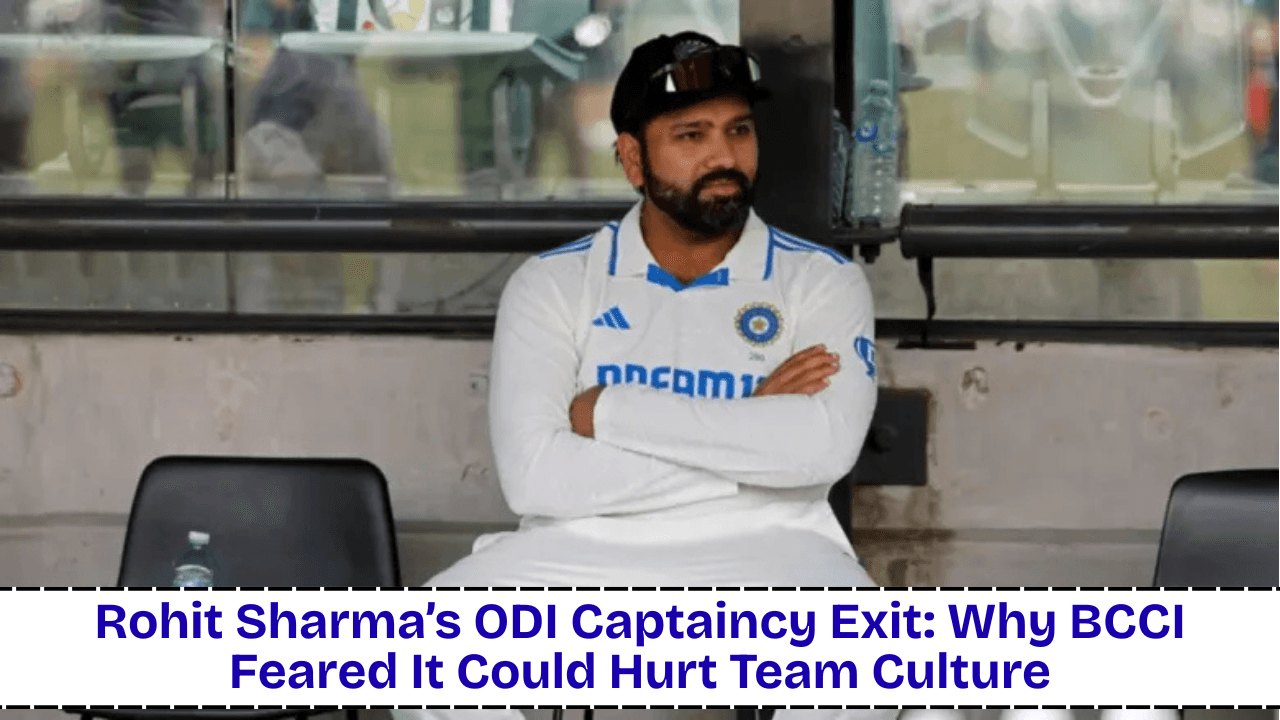Rohit Sharma ODI Captaincy Exit: Why BCCI Feared It Could Hurt Team Culture
The Board of Control for Cricket in India (BCCI)’s recent decision to hand over the ODI captaincy has reignited discussions across Indian cricket. While fans anticipated a leadership change sooner or later, sources now suggest that keeping Rohit Sharma as ODI captain might have “disturbed the team culture.”
At the same time, reports indicate that head coach Gautam Gambhir quietly strengthened his influence inside the dressing room — especially after India’s disappointing outings against New Zealand. These developments reveal a bigger story about team dynamics, leadership clarity, and the evolving power structure in Indian cricket.
Background: The Real Reason Behind the Change
- The Challenge of Three Captains
Chief selector Ajit Agarkar reportedly emphasized that having three different captains for Tests, ODIs, and T20Is was “very difficult” to manage in the long run.
Each format having its own leader was creating inconsistency in leadership style, messaging, and authority, which could confuse younger players and fragment the team’s culture.
With Rohit Sharma in ODIs, Shubman Gill leading Tests, and another face in T20Is, the selection panel saw a lack of synchronization in India’s cricketing vision.
To restore harmony, the board decided to streamline the leadership under a single, future-focused captaincy system.
- The “Team Culture” Concern

Insiders claim the management was worried that if Rohit continued in ODIs, he might unintentionally dominate the dressing room culture with his own philosophy — even though the format now sees fewer matches than Tests or T20s.
Such a situation, according to team insiders, could create a clash of ideologies between the captain and coach, disrupting the unified vision Gambhir was trying to build.
To be clear, this was not a question of Rohit’s capability. Rather, it was about ensuring consistency in communication and leadership tone across all formats.
In teams with multiple leadership centers — captain, coach, and selectors — it’s vital that one clear voice guides the group. The selectors felt this clarity was slipping away.
Gautam Gambhir’s Assertive Turn After the New Zealand Debacle
When Gambhir first became head coach, he reportedly stayed in the background, allowing Rohit to lead most discussions and tactical decisions. But things began to shift after India’s poor showings against New Zealand.
Post those defeats, Gambhir is said to have taken stronger control of dressing-room decisions, from player discussions to strategy meetings. This wasn’t about ego — it was about re-establishing a common purpose and bringing discipline back to a side that had started to drift.
The selectors recognized this shift and chose to support Gambhir’s vision fully, aligning captaincy decisions with his long-term roadmap.
Impact & Implications
✅ Advantages of the Change
- Unified Leadership Vision
A single captain across formats — or one in sync with the coach — ensures clear communication, tactical consistency, and emotional balance within the squad. - Long-Term Planning Under Youth Leadership
By giving Shubman Gill more responsibility, the management signals a transition toward the next generation of leaders, preparing the team for sustained success. - Coach–Captain Synergy
The new system eliminates the risk of split opinions between coach and captain, allowing Gambhir and Gill to work as one unit in decision-making.
⚠️ Challenges Ahead
- Managing Senior Emotions
Rohit Sharma’s leadership experience and legacy command deep respect. The transition must be handled carefully to avoid resentment or emotional disconnect. - Gill’s Learning Curve
While talented, Shubman Gill is still developing as a leader. He’ll face scrutiny, media pressure, and the challenge of commanding senior players’ trust. - Adjusting to New Culture
Team culture doesn’t change overnight. Players accustomed to Rohit’s calm, inclusive style will take time to adjust to Gambhir’s intense, result-driven approach.
What This Means for Rohit Sharma & Team India
Rohit Sharma’s chapter as captain may have closed, but his story in Indian cricket certainly hasn’t. He remains a key senior batsman and mentor, especially as India transitions under new leadership.
The selectors, meanwhile, have sent a strong message — there will no longer be multiple power centers. Instead, there will be defined roles, smoother communication, and a united team structure.
Whether this gamble pays off will depend on how effectively Gambhir and Gill align their vision, manage egos, and nurture trust within the squad.
Conclusion
The decision to move on from Rohit Sharma as ODI captain wasn’t just about age or performance — it was about protecting the team’s culture and ensuring leadership unity.
The BCCI and selection committee have clearly chosen to simplify the leadership puzzle and give Gautam Gambhir a stronger hand in shaping the team’s future.
As India prepares for the next phase, one thing is certain: this isn’t just a captaincy switch.
It’s a strategic cultural reset, designed to align India’s cricketing future under one clear and cohesive vision.
must read – zkfundaweb.com





Post Comment